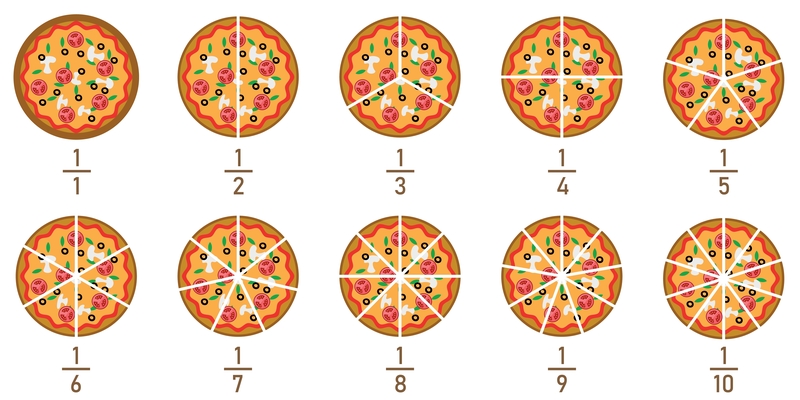Learning fractions is challenging for most students as they are not whole numbers. The basic concepts of fractions are not easily graspable, so kids find it challenging to understand the fraction values. If you do not provide a strong foundation in fractions, your kid will find it hard to learn other topics that are related to fractions. In PSLE Maths, fractions are a crucial topic no student can give up on. As they move on, fractions are used in other topics like percentage, decimal and ratio. Therefore, every candidate needs to be thorough in fractions. Students in Singapore can get support from StudySmart for their PSLE Maths revision by registering and downloading previous years' questions from their website.
Making the Understanding of P5 Fractions Easy
We will clear all the common misconceptions students frequently face in their P5 fractions with the help of examples.
Question 1
If you had a bag of flour weighing 3/4 kg and your friend Jane used 2/5 of it, how much flour have you left in the bag?
Solution
Amount of flour remaining: 1- 2/5, will be equal to 3/5.
Weight of the remaining flour: 3/5 of 3/4 kg will be equal to 6/20 kg, which, when further simplified, will give 3/10 kg.
For better understanding, explain elaborately to your child. 'It' here refers to the total flour weight, which is 3/4 kg. As Jane utilised 2/5 of the entire amount of the flour, the remaining flour left out will be 3/5.
In a fraction, the denominator is the total number of units. Here, in 2/5, the total number of units is 5, which indicates the total weight that is 3/4 kg. The numerator represents the quantity of flour Jane utilised.
If your kid still needs to understand the concept, you can teach them with whole numbers. Most students will be able to grasp the question when it is explained with whole numbers instead of fractions. You can make them understand by stating:
If you had a bag of flour weighing 10 kg and your friend Jane used 2/5 of it, how much flour have you left in the bag?
Weight of the remaining flour: 3/5 of 10, equal to 6 kg.
Question 2
If you had a bag of flour weighing 3/4 kg and your friend Jane used 2/5 kg of it, how much flour have you left in the bag?
Solution
Weight of the flour remaining: 3/4 – 2/5 which is equal to 7/20 kg
A good explanation for this will be: If Jane utilised 2/5 kg of it, it is understood that 'it' here refers to the weight of the total flour, which is 3/4 kg. Part is 2/5 kg whereas whole is 3/4 kg. In order to find out the part, we must subtract the used part from the total weight or whole.
As you compare both questions, you will be able to notice that there is a mild difference between them. It is the usage of the unit kg in the second question.
While simplifying question 2, you can change 3/4 to any whole number, say 10. And 2/5 to any smaller whole number, say 4. Now the question will be:
If you had a bag of flour weighing 10 kg and your friend Jane used 4 kg of it, how much flour have you left in the bag?
Weight of the remaining flour: 10 – 4, equal to 6 kg.
Ensure that your child is thorough with P5 fraction concepts. If they do not, it might affect them while learning P6 fractions. Thus, make the extra effort to help your child clear all their doubts when learning fractions at P4 and P5 levels.

Resolving the Concepts on Fraction of a Remainder & Total in a Simple Way
Here we have helped you understand how to tackle the concepts of "fraction of a remainder" and "fraction of a total" with two questions. The difference between the questions here are phrases, "1/4 of them" and "1/4 of the remaining balls". But the approach is totally different in both questions. Most students struggle to learn these basic concepts when they first attempt them.
Question 1
If you have a box with 1/3 of the balls in red, 1/4 in yellow and the remaining in blue, which is 30, how many balls does the box have?
Solution
1/3 will be equal to 4/12 as there will be 4 out of the 12 units of red balls.
1/4 will be equal to 3/12 as there will be 3 out of the 12 units of yellow balls.
12 units – 4 units – 3 units will be equal to 5 units.
5 units will be equal to 30
Therefore, 1 unit will be equal to 6
Totally, 12 units will be equal to 72
In the question, 'Ball' and 'them' refers to the total number of balls. We must first determine the common denominator for 1/3 and 1/4. The 12 denominator denotes the number of total balls in the box, which is 12 units.
Also Read : How Critical Thinking Elevates PSLE Maths Performance
Question 2
If you have a box with 1/3 of the balls in red, 1/4 of the remaining balls in yellow and the rest of the balls in blue, which is 30, how many balls does the box have?
Solution
3 units will be equal to 30
1 unit will be equal to 10
6 units will be equal to 60
Here we will not be able to find a common denominator for 3 and 4 as we did in question 1. Most students commit this common mistake as they don't know when they should determine the common denominator in problem sum when two fractions are given. You can state the difference between these sums by pinpointing the different phrases. And how 'balls' and 'remaining balls' do not mean the same.
PSLE Mathematics & Its Basic Concepts Pertaining to Fractions
There are a few concepts used in PSLE Mathematics. They are:
Branching or Remainder
This concept is used in percentage and fraction problems in PSLE Mathematics. You can identify by seeing the keyword 'remainder'.
Equal Fractions
This concept is used in many problems in PSLE Mathematics where the students have to make the denominator and numerator the same for comparison.
As Many As, Less Than, More Than
According to this concept, fractions greater than 1 will have their numerators bigger than their denominators. Whereas fractions lesser than 1 will have their numerators smaller than their denominators. And the remaining will be equal to 1.
Constants
The constants concept is used in the topic ratio in PSLE Mathematics. The meaning of constant is same. You will have to find the part that will remain constant and make it equal in both ratios.
Part Vs. Whole
Students must be clear with the 'whole' and 'part' in every problem in order to understand PSLE Math questions.
The Takeaway
The strategies mentioned above can also be used in other topics in PSLE Mathematics. Students in Singapore can register and log in to the StudySmart website and practice problems in fractions for their PSLE Maths revision processes.
